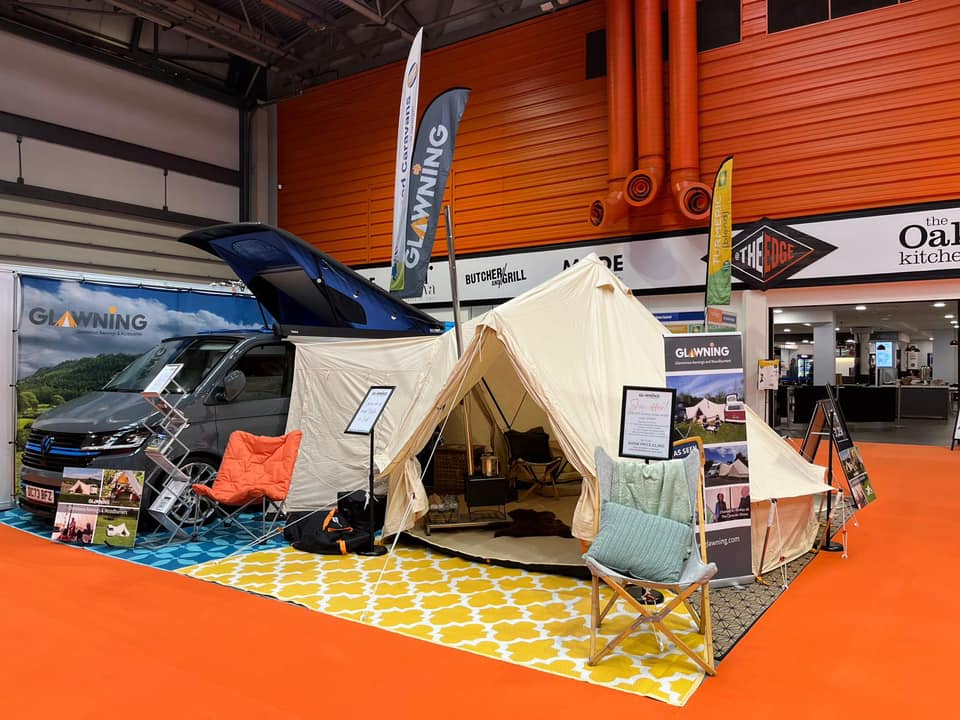What is a Glawning? How Does it Work? How Much Space Do I Need on a Camping Pitch?

A glawning is a hybrid of a glamping tent and an awning, designed primarily for campervans or caravans. It's essentially a high-quality canvas tent that attaches to the side of your camper or caravan, creating a spacious, weatherproof extension. The name "glawning" comes from combining the words "glamping" (glamorous camping) and "awning," highlighting its dual function as a comfortable living space and a stylish outdoor shelter. Glawning Director Sarah Martin came up with the name in a fit of inspired genius whilst sitting in the prototype back in 2012 and it has become a household name in it's own right.
How Glawnings Work
-
Attachment: The glawning connects to the side of your campervan or caravan, similar to a traditional awning, by sliding onto the awning rail on the vehicle. This can be done with the assistance of a drive-away kit which slides a strip of kador into the vehicle awning rail on one side and a figure of eight onto the beaded strip. This means it can be easily detached if you want to take your vehicle out while leaving the glawning in place.
-
Material: Glawnings are made from high-quality, durable, mildew resistant, waterproof polycotton, which is breathable and resistant to the elements. The material helps regulate temperature, keeping it cooler in summer and warmer in cooler weather.
-
Structure: They are bell-tent shaped, providing a spacious, circular living area. They are compatible with wood-burning stoves, fitted via a pre-cut stove jack, making them suitable for year-round use. The poles are strong and stable, and they are guy-roped down using heavy duty stakes ensuring durability in various weather conditions.
-
Multi-functionality: You can use a glawning as a living area, dining room, or even a sleeping area if you’re looking to expand your living quarters.
Benefits Over a Regular Awning
-
Comfort and Luxury: Unlike a regular awning (which often consists of thin nylon), a glawning offers the feel of a luxury camping tent. The polycotton material is not only more breathable and insulating, but also gives it a more aesthetically pleasing set up, particularly attractive with a beautiful vintage campervan or shiny new state of the art van.
-
Year-Round Usability: With the option to install a wood-burning stove, a glawning can be used comfortably in cold weather, which is not typical for standard awnings. Regular awnings are usually less well-insulated and more prone to condensation in cooler climates.
-
Spacious Design: Glawnings tend to offer more headroom and living space than a typical caravan awning, which often feels cramped. With a 3m high centre pole the bell-tent design makes it a much more versatile space for dining, lounging, or sleeping, especially if there are tall people in your group.
-
Durability: The polycotton canvas used to make glawnings is more robust and long-lasting compared to the synthetic materials of traditional awnings. The canvas can withstand harsher conditions like wind, rain, and sun over time. They are also very easy to repair making them a sustainable choice, better for the environment.
-
Aesthetic Appeal: The bell-tent design offers a more visually appealing setup, often preferred by those seeking a glamping experience.
-
Modularity: Not only are there multiple set up options within the glawning range (e.g. see the Hub for a real head turner) but you can easily detach the glawning from your camper or caravan and use it as a stand-alone tent, unlike most regular awnings. This means they provide a great investment for garden living, not just camping. Think al fresco chill out lounge, kids parties, sleepovers etc!
Space Requirements on a Pitch
A glawning diameter ranges from 4m to 5m depending on the model, so you need to account for this when booking a pitch.
-
Average Size: A standard 4m glawning would need around 4m of ground space in diameter, plus 1m for your connecting canopy, plus 1m for your van, plus an additional 1m for guy ropes.
-
Total Space: To ensure you have enough space on a pitch, you’d want a minimum of around 8m in width and 6m in depth to comfortably set up a glawning attached to your vehicle. For a 5m glawning it would be 9m x 7m.
It’s essential to check the pitch size limits at campsites in advance. See our handy ever-growing list of campsites here for inspo!





Leave a comment